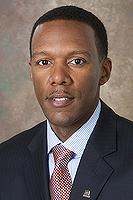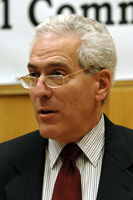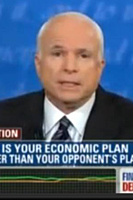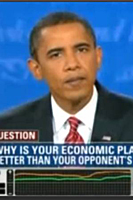
Observations of Center faculty on the political communication scene
 David C. Wilson
David C. Wilson
September 15, 2010
There’s much to discuss about the now finalized Delaware U.S. Senate race between Christine O’Donnell (R) and Chris Coons (D). Christine O’Donnell won the Republican primary over the long tenured U.S. Representative Mike Castle, 53% to 47% (+6% points).
This was a shocker to most, but what really happened was that turnout was higher than normal in lower Delaware, and lower than normal in northern Delaware. Polls underestimated these levels for most of the campaign, and thus, missed the trend. Plus, the lack of in-state polling provided no clues about the sources and substance of information that mobilized voters. It turns out that an old and well known state division has now moved into, at least, the Republican Party.
Castle won New Castle County 58% to 42%, but lost Kent and Sussex counties, 64% to 36%. O’Donnell’s support in both Kent and Sussex was twice that of Castle’s. It appears that Castle failed to mobilize moderate Republican support, and relied too heavily on the state party for his campaigning. O’Donnell was far more active raising funds, and getting out the vote, and it paid off.
Segue to the polls. The last poll conducted before the election (Public Policy Polling (PPP), 9/11-9/12) showed O’Donnell with a 47% to 44% advantage over Castle with 8% undecided, and a margin of error of roughly 4%. Thus, O’Donnell should have received anywhere between 43% and 51%, and Castle should have received between 40% and 48%. So, how did O’Donnell beat her estimate? As usual, the answer is probably turnout.
Approximately, 57,582 registered Republicans voted in Tuesday’s primary. An estimated 27,021 voted for Castle and 30,561 voted for O’Donnell; a vote difference of 3,540 (6% points). Interestingly enough, Castle received far more actual votes for Representative in 2008 than O’Donnell received for Senate. This suggests an absence of strong party loyalty in the 2008 elections—Republicans voted for Castle and Biden in relatively large numbers—but it does raise questions about how turnout might affect the state’s mid-terms; especially across counties in the state.
I think turnout will be the key because some of the popular media arguments about what’s going on in the state are somewhat untenable. The September PPP poll found that only 24% of Republicans consider themselves “members of the Tea Party,” and a plurality of 47% felt the Republican Party was “about right” in terms of its ideology; 17% felt the party was “too conservative.” Approximately 42% of Republicans expressed that a Sarah Palin endorsement would not make a difference in their vote for a candidate, and 24% said it would make them “less likely” to vote for a candidate. Thus, I see no big Tea Party movement in terms of attitudes and beliefs. However, Tea Party funding is related to turnout.
According to the state of Delaware’s Elections Commissioner, the 2010 Republican primary produced a 32% turnout rate. On the surface this might seem low; however, the turnouts for past Republicans primaries were 16% in 2008, 8% in 2006, 12% in 2004, 14% in 2002, and 16% in 2000. Thus, the 2010 primary doubled Republican turnout.
The PPP polling likely underestimated this higher than usual turnout when they calculated their likely voter estimate or in weighting their final estimates. So, what does this mean going forward? It’s likely that O’Donnell will continue to run the same type of campaign but receive more outside funding and attention. The interesting part will be how the electorate in Delaware, and the nation, responds to the results. Mid-term turnout percentages in the state usually hover around the mid to upper 40s, while in presidential election years, turnout is in the mid to high 60s.
O’Donnell’s Democratic opponent, New Castle County Executive Chris Coons has been leading public opinion in all head to head match-ups against O’Donnell. And, in the general election, O’Donnell will have to convince independent voters, moderate Republicans, and Castle supporters that she will represent their interests. This will be an uphill battle given that she’s already indicated that she feels she can win without “them” referring to the Republican Party Organization, and suggesting the GOP might be too lazy to help her.
All of this bodes well for Coons who will certainly win the Wilmington area, and much of the Wilmington suburbs which make up the largest portion of the state’s electorate. But, it’s tough to gauge Democratic turnout in the state because Coons did not have a primary challenger, and thus no indicator of support. Traditionally, Republican turnout during the primaries is slightly higher than Democrats, but in 2008 the latter’s turnout was 12% points higher than the former’s. O’Donnell’s win could actually work to mobilize support for Coons. It will also be interesting to see if Castle’s supporters, and perhaps Castle himself, will remain loyal to the party or decide to support Coons because he has governing experience and is not considered an outside candidate.
Another interesting question is whether or not Castle would consider a run as an Independent candidate. While the election is about a month and a half away, Castle has established support and could still pull in significant Republican support. This has a low chance of happening, but it’s still something we don’t know. After all, he is very popular in the state.
According to 2008 exit poll data on that year’s Senate race, 75% of Republicans voted for O’Donnell, while about 25% voted for Joe Biden, who was also running for Vice President. Biden won the contest by nearly 30% points, 64% to 35%. More telling, approximately 38% of Democrats voted for Mike Castle over his Democratic challenger, Karen Hartley-Nagel. Half of the individuals who say they voted for Castle in 2008, also voted for Democrat Joe Biden. In fact, 36% of Democrats who voted for Biden also voted for Castle. This all suggests that Castle has good standing among Democrats, which could hurt Coons, who according to Public Policy Polling, in early August held a 31% approval rating with 39% saying they were “unsure” about their approval of him.
What does all of this signal? First, the narrative about the campaign will change. The election will be more about O’Donnell than about Coons. She has struck a political win in her partnership with former Alaskan Governor and Vice Presidential candidate, Sarah Palin. People will certainly be curious about Coons, but he will not be the story; that is, unless he strikes a political win too (e.g., endorsement from Castle).
Second, Delaware will once again become a highly visible bell-weather for the political landscape. The GOP was undoubtedly counting on Castle’s popularity in the state to win that seat, and help take back the Senate. While that possibility is not closed, it does become much harder with a GOP candidate who doesn’t seem to get along with her own party.
Third, the media will heavily scrutinize the race and the candidates. O’Donnell is particularly vulnerable because she is a woman (yes, sexism still exists), she has no governing experience, she is not well known or revered by the state and national GOP, and there are many questions about her personal and campaign finances, educational background, ethics issues related to non-profit work, past gender discrimination lawsuits, and her personal relationships. O’Donnell does appear to be media savvy, but as things heat up, those skills will be tested.
Fourth, Coons’ single most important priority will need to be turnout. If he can mobilize support among the electorate in New Castle country, especially the suburbs of Wilmington, he will win the election. He should not ignore Kent and Sussex counties either; they hold more opportunities than barriers to his election. His message must be at least two-fold: he can govern and he will represent Delawareans with pride and uphold the reputation of the state. How he frames and packages those messages will be up to his campaign.
O’Donnell’s single most important priority will be to somehow move slightly more to the ideological and political center, and make friends with the state and national party. The September PPP poll showed O’Donnell having strong support only among self-described conservatives. Conservatives make up the largest portion of the Republican party in DE, but they are heavily outnumbered in the state when moderate Republicans are combined with all Democrats regardless of ideology.
Also, the outside funding may become a problem if Delawareans, who traditionally like to handle their own politics, perceive too much outside influence. O’Donnell must now come up with solid policy proposals that will show she can actually be effective in the male dominated, seniority ruled world of the Senate. She also has weak support among seniors, who heavily favored Castle.
Fifth, the October 13 debate at the University of Delaware, sponsored by the University’s Center for Political Communication will likely be the single most important event for both candidates. It will receive national coverage, and the sound bites and spin from the debate will be plastered on every cable political show, internet blog, and regional newspaper. It could be the biggest, and perhaps final, chance for the candidates to make their case for election.
Finally, this means that Delaware will elect someone other than Joe Biden for the first time in almost four decades. That’s big.
 Lindsay Hoffman
Lindsay Hoffman
July 28, 2010
Two big news events in the last week highlight the varying effects of technology on news production and values. First was the edited video of Shirley Sherrod which resulted in a media frenzy—in both new and traditional media—about Sherrod’s supposedly racist comments at an NAACP meeting. Of course, viewing the video in its entirety revealed that the comments were not racist, but demonstrated how Sherrod overcame her feelings about race to help farmers in need. But her forced resignation came before that truth was revealed, and apologies and “teachable moments” haven’t necessarily healed that wound. Second was WikiLeaks’ release of thousands of documents about the war in Afghanistan and the massive stories in the New York Times, Der Spiegel, and the Guardian—news organizations that were given the documents weeks in advance.
Both of these stories resulted from advances in technology—what makes them different is how the information was handled. The Sherrod story followed a familiar trajectory: journalists jumped on a high-conflict story with good video without checking it out first, demonstrating the power of high-speed technology and the subsequent leap to judgment in the face of competition. When the truth was revealed, many journalists expressed regret, but quickly moved on to the next story. The WikiLeaks story, on the other hand, demonstrates that technology can only take a story so far—Julian Assange of WikiLeaks provided the documents to three traditional media organizations because, no doubt, the effect of releasing them on his web site alone would not have the staying power or the attention that these traditional organizations could give them. So in this case, speed and rush to publish perished over context and depth—two of those journalistic features that many have lamented are disappearing in a new media age.
What does this mean for journalism? It means journalists are still making mistakes and learning the ropes of new technology, but they’re also still providing viable and necessary contributions to public affairs. Technology has changed the pattern of reporting, the half-life of stories, and how journalists and audiences view news itself, but it hasn’t necessarily revolutionized journalism—at least not yet. But at the very least, the way these two stories were handled demonstrates that technology hasn't had a monolithic effect on news production or values.
 David C. Wilson
David C. Wilson
July 4, 2010
Most of the time when people participate in public opinion polls and surveys they answer questions with information they have at the top of their mind. Rarely do they consider the fact that questions that appear earlier in a survey can influence responses to questions later, especially when the topics are highly connected. This “response bias” is called a “question-order context effect.” Sometimes the effect is strong; sometimes it is weak. In my article published in the Summer 2010 issue of Public Opinion Quarterly, I note that the strength of the context effect can depend on one’s identification with an important and relevant group.
It turns out that beliefs about out-group racial prejudice (how much another group dislikes one’s own group) is influenced by one’s thinking about how prejudiced their own in-group is toward the out-group (how much one’s own group dislikes another group). The research suggests that trends in perceptions of race relations are misinterpreted when data are not broken down by race, and when the topics and ordering of the questions are not considered. For instance, responses to questions evaluating Democrats/Liberals and Republican/Conservatives will likely depend on not only whether one is a Democrat/Liberal or Republican/Conservative, but also which group is evaluated first in the survey interview.
Read the entire article here.
 Jennifer L. Lambe
Jennifer L. Lambe
January 22, 2010
Citizens United v. FEC, the decision released yesterday by the U.S. Supreme Court, will have major implications for election communication in the United States. The decision overturns a century of laws and judicial precedent to grant corporations and other organizations with large coffers a virtually unlimited ability to influence federal elections.
At the core of the majority’s decision is the misguided notion that corporations have rights equal to that of individuals. While this premise makes for nice rhetorical strategy, Congress and the courts have consistenly reiterated the dangers that come from treating non-human entities as equal to human beings in the realm of elections. The majority shows disregard for the principle of stare decisis, despite the fact that several of the justices in the majority address this issue at length in the court’s nearly 200-page opinion (they doth protest too much?).
Most importantly, in practical terms, the ability for corporations and other wealthy organizations now to spend directly from their general treasury funds will result in an avalanche of advertising and advocacy whose sole aim is to further their economic interests. Until yesterday, such expenditures had to be paid for out of political action committees, which received voluntary contributions from shareholders and employees – now a corporation can spend its profits for campaign messages. Imagine the impetus health insurance companies will have in the fall midterm elections, to use their vast resources to defeat candidates who support insurance reforms. At the very least, the perception of integrity in national politics will be greatly damaged.
The marketplace of ideas should not be equated with the economic marketplace, where those with the most money have the loudest voices.
 Ralph J. Begleiter
Ralph J. Begleiter
January 22nd, 2010
The Supreme Court’s decision overturning the longstanding ban on corporations advertising on behalf of – or against – political candidates could have an interesting effect on television’s so-called “news” channels.
Under the new high court ruling, the thinly veiled political advocacy of channels like MSNBC and Fox News could legally become a juggernaut no longer limited to the relatively small number of viewers of those channels. Now, for the first time in the history of those all-“news” channels, the sharply defined political views of their corporate owners could become inescapable to viewers of other, much more popular television outlets. Millions more people regularly watch ABC, NBC or CBS than watch CNN, Fox or MSNBC.
Rupert Murdoch, the global conservative media mogul who has legally used his own “news” channel and newspapers in his political service in the past, will now be able to use the corporate profits of his media outlets to buy political advertising on traditionally unaffiliated media – say, ABC or CNN. Game shows and soap operas, talk shows and even news programs on competing networks could now, legally, become drenched in corporate political advocacy, including notoriously effective negative campaign ads. With the Supreme Court’s new imprimatur, Murdoch’s political favorites could be boosted not just on his own outlets, but everywhere else he chooses to buy partisan ads.
Another phenomenon to watch for: during an election year in the United States, political television advertising is most effective at the local level. The Philadelphia area, for instance, was a television battleground in 2000, 2004 and 2008 between the Republican and Democratic parties. Citizens in Pennsylvania, New Jersey and Delaware could hardly escape the barrage of political TV ads during those presidential campaigns. Local TV stations have long profited smartly from such advertising by the hundreds of millions of dollars.
Under the new Supreme Court ruling, look for ad spending in local television markets to balloon with slick and expensive corporate ads, paid for from deep pockets beyond even the wildest dreams of the candidates and their parties. In fact candidates themselves could have a hard time squeezing their own campaign ads onto screens in hotly-contested local TV markets, because ad slots could become so clogged with well-financed corporate-interest advertising.
 David C. Wilson
David C. Wilson
November 20, 2009
Who’s being blamed for the recession?
This is the first note in a series of briefs related to the presentation of political polling information from various outlets. The Toplines are the different numbers presented in a report or new story containing poll data, and the headlines are of course what is supposed to be the “best” summary of the information to follow. The goal of “Toplines and Headlines” is to help the average consumer of politics to better understand how polls are used to support narratives, or broader themes the authors, producers, or outlets are attempting to pose to the public. Readers should not consider these briefs a criticism of polling or poll data, but rather use these notes to question the inferences made by those providing the story.
Today (11/20/09) the CNN website released a headline that read, “Poll: Public shifting blame for recession.” The story used data from a November poll of U.S. adults (N=1,014) conducted between the 13th and 15th, with a “margin of error” at plus or minus 3%. The headline suggests that there is a meaningful change in who the public is blaming for the recession. The topline information found that in May, 53% of the public blamed the Republicans for the recession, and that number is now only 38%, a 15% decrease.
The CNN Polling Director, Keating Holland notes this is a bad sign for the Democrats because if the numbers continue to decline “only a handful of Americans will blame the economy on the Republicans” by the time the 2010 elections roll around. Yet, according to the poll, 27 percent now blame the Democrats for the recession, up 6 points from May (33%), and 27 percent now say both parties are responsible.
A sophisticated poll watcher would raise several concerns after reading this story. First, when using samples “point” estimates (a single number) are less important than “interval” estimates (point estimates with the margin of error considered). The margin of error for this poll, as well as the others, is at least 3%, which means the numbers for Democrats is anywhere from 24% to 30% now, and 30% to 36% back in May; thus, while the Republican blame numbers have clearly decreased, there is a chance that the numbers for Democrats haven’t changed at all: 30% then and 30% now.
Second, watch out for the shell game with numbers. More Americans still believe the Republicans are responsible for the recession (by 11% over Democrats), and while the Republicans have decreased public blame by 15% and the Democrats have only decreased by 6%; why is the shift not uniform for the parties? The real number to keep your eye on is the one that hardly gets any mention: the percent of those who blame “both parties” which is now at 27%, a number which is equal to the Democrats numbers. While the Republicans are not being blamed as much as they were 2 months after the President took office (i.e., the honeymoon period), the blame is not necessarily shifting “to” the Democrats. The group taking the main hit on the recession is actually Congressional incumbents for both parties. According to Gallup’s daily tracking, these numbers has been on a steady decline since March of 2009.
Third, beware of the opinions behind the inferences; evidence is more important than guessing. Keating suggests that growing concerns over the budget deficit may be to blame; stating that two-thirds believe the government should balance the budget even in times of war. However, there is no evidence in the story that the two beliefs—who’s responsible, and the budget deficit—are connected. It would be a simple task to “cross-tab” the two questions to show that those who believe the budget should be balanced are also more likely to blame the Democrats for the recession. The omission of this information should always raise concerns about the strength of the claims.
Fourth, keep in mind the context. Since May, the American public has seen the passing of an unpopular stimulus bill, the passage of the largest budget in the history of the country, a fierce ideological and partisan debate about health care, and a contentious set of November 2009 elections, and most poll results comparing Democrats and Republicans, as well as Obama to other groups, still show statistically significant advantages for the Democrats and the President. This is particularly clear, when the public are asked “who do you trust more to handle the country’s problems?” and the President has the highest numbers, followed by the Democrats, and then the Republicans.
In summary, it’s important to remember that headlines are a means to an end; they persuade us to read a story as well as establish our expectations for what’s to come. The challenge is that by anchoring our expectations they can often lead to us assimilating what’s in the story to the actually headline, rather than evaluating the merits of the points in the story. This is particularly dangerous with poll data, and its quantitative literacy requirement. Remember to always keep in mind that trends are not always comparable, that inferences based on opinions and not facts can lead to misreading the public (this happens a lot), that numbers by themselves are not a “story,” and always keep in mind the context when thinking about what the numbers actually indicate.

 November 19, 2009
November 19, 2009
Lindsay Hoffman
At the annual meeting of the Midwest Association for Public Opinion Research, I presented a paper evaluating the influence of technology on perceptions of presidential debates. In the fall of 2008, a student researcher and I had subjects view two of the presidential debates--one group viewed the debates live on CNN with the infamous "squiggly lines" on the bottom of the screen representing real-time reactions of a focus group, and the other group viewed the "clean" debates on PBS. We were curious what effects viewing these lines might have on audience members. It turns out that those ubiquitous lines significantly impacted their perceptions of who won the debate -- in both debates, the group who viewed the squiggly lines were more likely to think Obama won than the group who viewed the debate without them. But, the squiggly lines had absolutely no effect on how much the audience liked the debate or whether they would be likely to participate in political activities leading up to the election. So does it even matter that the squiggly lines influenced who they thought won? It certainly shaped their perceptions of reality, but since the presidential debates aren't even "debates" in the true sense of the word, where there is a clear winner, these results suggest that the squiggly lines may just be affecting perceptions sooner than we've seen in years past. Those post-debate spin rooms and news coverage of debates have been shown to shape these very perceptions for years. And it's likely we'll continue to see more evaluation and more technology in future debates. In 2012, perhaps we'll be able pick and choose whose real-time reactions we want displayed on the bottom of the screen -- liberals and conservatives, Boomers and Gen-Xers, maybe even Hockey Moms and Nascar Dads...

University of Delaware Center for Political Communication
by Ralph J. Begleiter
It's been fascinating watching the political communication "Battle of the Books" this month between the Obama Democrats and the Republicans. David Plouffe's, "Audacity to Win" took him to the talk shows just a couple weeks before Sarah Palin's, "Going Rogue." Is it just me, or does it appear their competing publishers (Viking and Harper) might have actually conspired carefully so their releases didn't cut into each other's initial publicity blast? Wasn't that sort of thing once called "collusion?" Maybe it's relevant today, when high-tech web diffusion of both characters broadcast interviews are instantly parsed and distributed through political web sites, Facebook and other news outlets. Guess we shouldn't be surprised to see large images of the book covers (conveniently provided by the publishers to the wire services, newspapers and web outlets) accompanying reviews and commentary about the content.
By the way, In the runup to Palin's "Rogue" release, Republicans not in her corner waited anxiously to see how she paints them. And some Democrats were rooting for her to widen the apparent rift in the GOP between pragmatists and core believers, with her version of events.